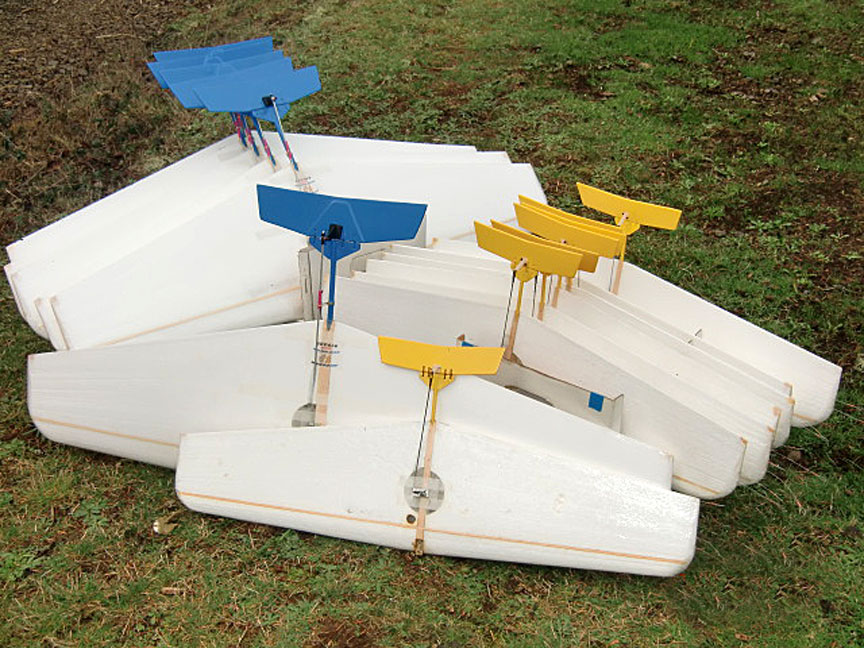An internal line-tension Combat shutoff
Russ Hester's fleet of AMA Fast and High-Performance 1/2-A Combat planes for 2019, with all planes fitted with his home-made line-tension internal flyaway shutoff. All photos by Russ Hester
By Russ Hester
(EDITOR'S NOTE: Line-tension shutoffs have been demonstrated as the best way to immediately render harmless any Combat planes cut loose during a match. The most effective of those produced so far, such as the very reliable H&R, have required external controls. There have been some internal line-tension shutoffs offered commercially, but they have their own problems; usually they involve a "third line" that arms the shutoff, but which also makes the plane difficult to control after the engine stops. Russ Hester of Florence, Ore., has developed a reliable shutoff that overcomes the problems usually associated with internal-control shutoffs. In this article, he explains how to make the devices.)
This fuel shutoff original idea comes from a Bob Mears shutoff. I was at Gene Pape's shop one afternoon talking shutoffs. Gene showed me his idea that he had some problems with; we threw some ideas around and came up with this, and he let me run with it. He gave me a machined pinch block. I have since made it so that no machining is needed. By the way, Gene's original idea was/is to retofit into the Russian models. It was successful. I have had success in Fast and now 1/2-A.

A close-up of the shutoff installed in an airplane.
Construction
To make the spring, I used a self-built fixture. I use .047" music wire for Fast and 80mph and .039" for 1/2-A.

I cut and attach thick-wall .125 brass tubing to spring. Cut one to the thickness part of airfoil and the other .400 longer
so it will stick above and go though pinch block. See photo above. The photos below show the fixture, the process of bending the wire, and the resulting springs and tubing.



Make pinch block out of J channel by cutting at .500 lengths. Drill and slot a 3/16 hole along with mounting holes, push the short end of the spring though the center section, slide the bellcrank onto the longer brass tube. Push the bellcrank spring together and attach the pinch block to the top of the center section with 2-56 screws as shown in the picture below. A bypass spring must be made for engine starting and launching, I just bend a .312" dia extension spring as the picture shows.





A bypass spring must be made for starting and launching of the plane. I bent a .312" dia extension spring as the pictures below show. Top photo below shows the shutoff held open by the spring; bottom photo shows the spring disengaged as in flight.


So how does it work?
Run 1/8" latex tubing from the bladder down the channel past the pinch rod, when the bypass spring is activated, to the needle valve. Fuel will flow at this point, the engine can be started and the plane can be launched. When plane gets line tension, the bypass spring will pop up and now activate the shutoff. When line tension is lost, fuel supply will be pinched off.
The photos below show the shutoff with fuel line routed through it.

Arming spring is hooked over the bellcrank post to allow starting and launch.

Arming spring is disengaged.
I get J channel from McMaster-Carr, part # 8427A52. Thick-wall brass tubing I get from Online Metals, Online Metals, Part # 4372. I get carbon-fiber bellcranks from Streamershuttle.
Be safe and use fuel shutoffs.
!!!!!!!!!!!!!!!! BUILDER AND USER ASSUME ALL RISK AND RESPONSIBILITY !!!!!!!!!!!!!!!!!!!
Back to Combat section
Flying Lines home page
This page was upated Jan. 31, 2019

